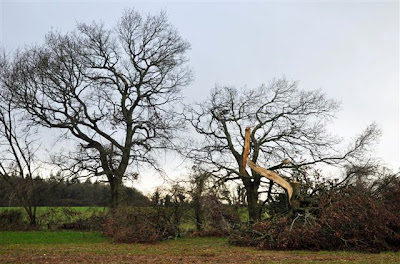 |
| The creation of a wetland areas can transform a piece of countryside |
Some level of targeting, when it comes to spending
Government money is necessary I'm certain, but surely this approach must never
leave large tracts of land within our countryside completely “untargeted” or
considered to be worthless in conservation terms.
If an area is for instance a “hotspot” for farmland birds,
then OK, look after them so that they don’t decline further, but at the same
time we should surely be managing the outer circles to this inner hotspot, so
that we expand birds back onto land that they have been lost from.
Sir John Lawton’s report “Making space for nature”, which
was published in 2010, is now regularly quoted throughout Government documents, stating their biodiversity targets for 2020. Lawton’s report was all about bigger,
better and more, in other words working on a landscape scale to join up special
areas of habitat and create new areas in between to act as stepping stones
across the countryside.
But is this happening in reality?
Last week I met up with a good friend and top notch
conservation adviser in the west Midlands. He is incredibly well respected in
the “patch” that he works and over a period of time he has enthused many a farmer
to create all sorts of diverse new habitats in a landscape that was, quite
frankly, relatively unexciting when it came to farmland wildlife.
Take one such farm. He has helped the farmer create a large
area of wetland, plant mixtures to attract hoards of insects in the summer
months and grown big plots of seed bearing plants to provide stacks of food
over-winter. He has put in cultivated
bare plots for Lapwing to nest on and leaves weedy stubbles over winter, while
many of the trees are dotted with numerous nest boxes.
So, what has been the result of all this hard work? Well,
quite frankly it is staggering. The farm now boasts breeding Redshank (a
species that had completely gone from the surrounding countryside as a nesting
species!), Lapwing have turned up in good numbers and happily use the plots
provided for them and Tree sparrows, a bird that has declined alarmingly, have established
a thriving colony based around the nest boxes provided.
I have been to this farm and the first thing you notice is
the bird song. The Skylarks were deafening and from what seemed like every
available vantage point, Yellowhammer gleefully sang their “little bit of bread
and no cheese” song. Meanwhile small groups of Linnet and Goldfinch flocked
together, their high pitched trills filling the air, until they landed near to
a herd of grazing cattle and fell silent. Hares too have come back in their
droves and can be seen chasing each other around in the morning sunshine.
If Lawton visited here, I'm sure he would imagine that this
is one of the nature reserves that he spoke about in his report and would
suggest that it was somehow linked to other good areas. But no, this is not a
nature reserve – it is a working farm. Take one enthusiastic farmer and add a
practical and knowledgeable adviser, carefully using money from a Stewardship
scheme which was available to all farmers and you can turn a previously
un-exciting piece of England into a rich wildlife haven.
Meanwhile, this part of the west Midlands is a target area
for woodland planting, funded by Government money too. However, trees and birds like Redshank, Lapwing and
Skylark just don’t mix – these species like an “open” landscape. So my friend
talked to the Forestry Commission and explained that Government money had been
spent on this scheme and that it had been very successful in delivering
declining target species to an area that had previously lost them. The reply
was along the lines of “Species mapping does not show that this is an important
area for farmland birds – so we will continue to plant trees here”.
So, two sources of Government money clash with each other,
probably resulting in time with the loss of these farmland birds as breeding
species in the area. What a waste of both money and effort.
But that is exactly why targeting is necessary I here you
say, so this sort of thing does not happen.
To an extent maybe, but what has happened to diversity? Are
we really going to finish up with a countryside that is polarised into sections
of habitat or species? If you want to see farmland birds, then go to Wiltshire.
Brown Hares? Northumberland is the place to see them. Woodland? That will be the
west Midlands. And what about farming? Oh! The lovely deep soils of Essex will
be the agricultural area of course!
As new schemes take shape over the coming months and plans are
prepared, stating how we are to use the new round of money recently allocated
to the management of the countryside – we must all work closely together,
making sure that we spend wisely and creatively to help maintain and enhance
our wonderfully diverse British landscape. Otherwise, we may simply be funding
its destruction.









